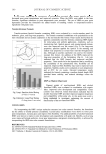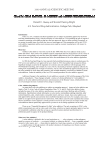REGULATION OF ECM REMODELING BY XANTHOHUMOL 131 (3) J. Varani, R. L. Warner, and M. Gharaee-Kermani, Vitamin A antagonizes decreased cell growth and elevated collagen-degrading matrix metalloproteinases and stimulates collagen accumulation in natu- rally aged human skin, J. Invest. Dermatol., 114, 480–486 (2000). (4) C. Lee, H. Choi, H. Kim, D. Kim, I. Chang, H. T. Moon, S. Lee, W. K. Oh, and E. Woo, Bifl avonoids isolated from Selaginella tamariscina regulate the expression of matrix metalloproteinase in human skin fi broblasts, Bioorg. Med. Chem., 16, 732–738 (2008). (5) M. R. Khorramizadeh, E. E. Tredget, C. Telasky, Q. Shen, and A. Ghahary, Aging differentially modu- lates the expression of collagen and collagenase in dermal fi broblasts, Mol. Cell. Biochem., 194, 99–108 (1999). (6) A. J. Millis, M. Hoyle, H. M. McCue, and H. Martini, Differential expression of metalloproteinase and tissue inhibitor of metalloproteinase genes in aged human fi broblasts, Exp. Cell. Res., 201, 373–379 (1992). (7) A. Berton, G. Godeau, H. Emonard, K. Baba, P. Bellon, W. Hornebeck, and G. Bellon, Analysis of the ex vivo specifi city of human gelatinases A and B towards skin collagen and elastic fi bers by computer- ized morphometry, Matrix Biology, 19, 139–148 (2000). (8) M. Brennan, H. Bhatti, K. C. Nerusu, N. Bhagavathula, S. Kang, G. J. Fisher, J. Varani, and J. J. Voor- hees, Matrix metalloproteinase-1 is the major collagenolytic enzyme responsible for collagen damage in UV-irradiated human skin, Photochem. Photobiol., 78, 43–48 (2003). (9) N. Tsuji, S. Moriwaki, Y. Suzuki, Y. Takema, and G. Imokawa, The role of elastases secreted by fi bro- blasts in wrinkle formation: Implication through selective inhibition of elastase activity, Photochem Pho- tobiol., 71, 283–290 (2001). (10) F. Rijken, R. C. Kiekens, E. van den Worm, P. L. Lee, H. van Weelden, and P. L. Bruijnzeek, Pathophys- iology of photoaging of human skin: Focus on neutrophils, Photochem. Photobiol. Sci., 5, 184–189 (2006). (11) F. Rijken, R. C. Kiekens, and P. L. Bruijnzeek, Skin-infi ltrating neutrophils following exposure to solar- simulated radiation could play an important role in photoageing of human skin, Br. J. Dermatol., 152, 321–328 (2005). (12) E. Jung, J. Lee, J. Baek, K. Jung, J. Lee, S. Huh, S. Kim, J. Koh, and D. Park, Effect of Camellia japon- ica oil on human type I procollagen production and skin barrier function, J. Ethnopharmacol., 112, 127–131 (2007). (13) H. S. Cho, M. H. Lee, J. W. Lee, K. O. No, S. K. Park, H. S. Lee, S. Kang, W. G. Cho, H. J. Park, K. W. Oh, and J. T. Hong, Anti-wrinkling effects of the mixture of vitamin C, vitamin E, pycnogenol and evening primrose oil, and molecular mechanisms on hairless mouse skin caused by chronic ultraviolet B irradiation, Photodermatol. Photoimmunol. Photomed., 23, 155–162 (2007). (14) J. Labat-Robert, A. Fourtanier, B. Boyer-Lafargue, and L. Robert, Age dependent increase of elastase type protease activity in mouse skin. Effect of UV-irradiation, J. Photochem. Photobiol B, 57, 113–118 (2000). (15) K. K. Lee and J. D. Choi, The effects of Areca catechu L extract on anti-aging, Int. J. Cosmet. Sci., 21, 285–295 (1999). (16) Y. H. Kim, K. S. Kim, C. S. Han, H. C. Yang, S. H. Park, K. I. Ko, S. H. Lee, K. H. Kim, N. H. Lee, J. M. Kim, and K. H. Son, Inhibitory effects of natural plants of Jeju Island on elastase and MMP-1 expression, J. Cosmet. Sci., 58, 19–33 (2007). (17) K. Tsukahara, H. Nakagawa, S. Moriwaki, Y. Takema, T. Fujimura, and G. Imokawa, Inhibition of ul- traviolet-B-induced wrinkle formation by an elastase-inhibiting herbal extract: Implication for the mechanism underlying elastase-associated wrinkles, Int. J. Dermatol., 45, 460–468 (2006). (18) F. Jimenez, T. F. Mitts, K. Liu, Y. Wang, and A. Hinek, Ellagic and tannic acids protect newly synthe- sized elastic fi bers from premature enzymatic degradation in dermal fi broblast cultures, J. Invest. Derma- tol., 126, 1272–1280 (2006). (19) N. Philips and J. Devaney, Benefi cial regulation of type I collagen and matrixmetalloproteinase-1 ex- pression by estrogen, progesterone and its combination in skin fi broblasts, J. Am. Aging Assoc., 26, 59– 62 (2004). (20) N. Philips, J. Smith, T. Keller, and S. Gonzalez, Predominant effects of Polypodium leucotomos on mem- brane integrity, lipid peroxidation, and expression of elastin and matrixmetalloproteinase-1 in ultravio- let radiation exposed fi broblasts, and keratinocytes, J. Dermatol. Sci., 32, 1–9 (2003). (21) N. Philips, T. Keller, C. Hendrix, S. Hamilton, R. Arena, M. Tuason, and S. Gonzalez, Regulation of the extracellular matrix remodeling by lutein in dermal fi broblasts, melanoma cells, and ultraviolet ra- diation exposed fi broblasts, Arch. Dermatol. Res., 299, 373–379 (2007).
JOURNAL OF COSMETIC SCIENCE 132 (22) X. Z. Song, J. P. Xia, and Z. G. Bi, Effects of (-)-epigallocatechin-3-gallate on expression of matrix metalloproteinase-1 and tissue inhibitor of metalloproteinase-1 in fi broblasts irradiated with ultraviolet A, Chin. Med. J. (Engl.), 117, 1838–1841 (2004). (23) C. Ende and R. Gebhardt, Inhibition of matrix metalloproteinase-2 and -9 activities by selected fl avo- noids, Planta Med., 70, 1006–1008 (2004). (24) S. K. Katiyar, Matrix metalloproteinases in cancer metastasis: Molecular targets for prostate cancer prevention by green tea polyphenols and grape seed proanthocyanidins, Endocr. Metab. Immune Disord. Drug Targets, 6, 17–24 (2006). (25) M. A. Zaid, F. Afaq, D. N. Syed, M. Dreher, and H. Mukhtar, Inhibition of UVB-mediated oxidative stress and markers of photoaging in immortalized HaCaT keratinocytes by pomegranate polyphenol extract POMx, Photochem. Photobiol., 83, 882–888 (2007). (26) J. H. Lee, J. H. Chung, and K. H. Cho, The effects of epigallocatechin-3-gallate on extracellular matrix metabolism, J. Dermatol. Sci., 40, 195–204 (2005). (27) C. Gerhauser, A. Alt, E. Heiss, A. Gamal-Eldeen, K. Klimo, J. Knauft, I. Neumann, H. R. Scherf, N. Frank, H. Bartsch, and H. Becker, Cancer chemopreventive activity of xanthohumol, a natural product derived from hops, Molec. Cancer Ther., 1, 959–969 (2002). (28) E. C. Colgate, C. L. Miranda, J. F. Stevens, T. M. Bray, and E. Ho, Xanthohumol, a prenylfl avonoid derived from hops induces apoptosis and inhibits NF-kappaB activation in prostate epithelial cells, Cancer Lett., 246, 201–209 (2007). (29) F. Zhao, H. Nozawa, A. Daikonnya, K. Kondo, and S. Kitanaka, Inhibitors of nitric oxide production from hops (Humulus lupulus L), Biol. Pharm. Bull., 26, 61–65 (2003). (30) M. Tripp, G. Darland, R. Lerman, D. Lukaczer, J. Bland, and J. Babish, Hop and modifi ed hop extracts have potent in vitro anti-infl ammatory properties, Acta Hort., 668, 217–228 (2005). (31) C. R. Overk, P. Yao, L. R. Chadwick, D. Nikolic, Y. Sun, M. A. Cuendet, Y. Deng, A. S. Hedayat, G. F. Pauli, N. R. Farnsworth, R. B. van Breemen, and J. L. Bolton, Comparison of the in vitro estrogenic activities of compounds from hops (Humulus lupulus) and red clover (Trifolium pretense), J. Agric. Food Chem., 53, 6246–6253 (2005).
Purchased for the exclusive use of nofirst nolast (unknown) From: SCC Media Library & Resource Center (library.scconline.org)





































































































































